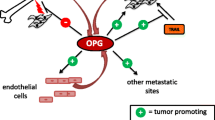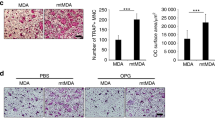Abstract
Osteopontin (OPN) has been implicated as an important mediator of breast cancer progression and metastasis and has been investigated for use as a potential therapeutic target in the treatment of breast cancer. However, the in vivo antitumor effect of anti-OPN antibodies on breast cancer has not been reported. In this study, a mouse anti-human OPN antibody (1A12) was humanized by complementarity-determining region grafting method based on computer-assisted molecular modeling. A humanized version of 1A12, denoted as hu1A12, was shown to possess affinity comparable to that of its parental antibody. The ability of hu1A12 to inhibit cell migration, adhesion, invasion and colony formation was assessed in a highly metastatic human breast cancer cell line MDA-MB-435S. The results indicated that hu1A12 was effective in inhibiting the cell adhesion, migration, invasion and colony formation of MDA-MB-435S cells in vitro. hu1A12 also showed significant efficacy in suppressing primary tumor growth and spontaneous metastasis in a mouse lung metastasis model of human breast cancer. The specific epitope recognized by hu1A12 was identified to be 212NAPSD216, adjacent to the calcium binding domain of OPN. Our data strongly support that OPN is a potential target for the antibody-based therapies of breast cancer. The humanized anti-OPN antibody hu1A12 may be a promising therapeutic agent for the treatment of human breast cancer.






Similar content being viewed by others
References
Denhardt DT, Guo X (1993) Osteopontin: a protein with diverse functions. FASEB J 7:1475–1482
Wai PY, Kuo PC (2004) The role of osteopontin in tumor metastasis. J Surg Res 21:228–241
Rodrigues LR, Teixeira JA, Schmitt FL, Paulsson M, Lindmark-Mänsson H (2007) The role of osteopontin in tumor progression and metastasis in breast cancer. Cancer Epidemiol Biomarkers Prev 16:1087–1097
Senger DR, Perruzzi CA, Papadopoulos A (1989) Elevated expression of secreted phosphoprotein I (osteopontin, 2ar) as a consequence of neoplastic transformation. Anticancer Res 9:1291–1299
Brown LF, Papadopoulos-Sergiou A, Berse B, Manseau EJ, Tognazzi K, Perruzzi CA, Dvorak HF, Senger DR (1994) Osteopontin expression and distribution in human carcinomas. Am J Pathol 145:610–623
Denhardt DT (1996) Oncogene-initiated aberrant signaling engenders the metastatic phenotype: synergistic transcription factor interactions are targets for cancer therapy. Crit Rev Oncogenes 7:261–291
Chakraborty G, Jain S, Patil TV, Kundu GC (2008) Down-regulation of osteopontin attenuates breast tumor progression in vivo. J Cell Mol Med. doi:10.1111/j.1582-4934.2008.00263.x
Behrend EI, Craig AM, Wilson SM, Denhardt DT, Chambers AF (1995) Expression of antisense osteopontin RNA in metastatic mouse fibroblasts is associated with reduced malignancy. Ann N Y Acad Sci 760:299–301
Behrend EI, Craig AM, Wilson SM, Denhardt DT, Chambers AF (1994) Reduced malignancy of ras-transformed NIH 3T3 cells expressing antisense osteopontin RNA. Cancer Res 54:832–837
Adwan H, Bäuerle T, Najajreh Y, Elazer V, Golomb G, Berger MR (2004) Decreased levels of osteopontin and bone sialoprotein II are correlated with reduced proliferation, colony formation, and migration of GFP-MDA-MB-231 cells. Int J Oncol 24:1235–1244
Wai PY, Mi Z, Guo H, Sarraf-Yazdi S, Gao C, Wei J, Marroquin CE, Clary B, Kuo PC (2005) Osteopontin silencing by small interfering RNA suppresses in vitro and in vivo CT26 murine colon adenocarcinoma metastasis. Carcinogenesis 26:741–751
Cui R, Takahashi F, Ohashi R, Gu T, Yoshioka M, Nishio K, Ohe Y, Tominaga S, Takagi Y, Sasaki S, Fukuchi Y, Takahashi K (2007) Abrogation of the interaction between osteopontin and alphavbeta3 integrin reduces tumor growth of human lung cancer cells in mice. Lung Cancer 57:302–310
Allan AL, George R, Vantyghem SA (2006) Role of the integrin-binding protein osteopontin in lymphatic metastasis of breast cancer. Am J Pathol 169:233–246
Chambers AF, Groom AC, MacDonald IC (2002) Dissemination and growth of cancer cells in metastatic sites. Nat Rev Cancer 2:563–572
Cole BF, Gelber RD, Gelber S, Coates AS, Goldhirsch A (2001) Polychemotherapy for early breast cancer: an overview of the randomised clinical trials with quality-adjusted survival analysis. Lancet 358:277–286
Clarke M, Collins R, Darby S, Davies C, Elphinstone P, Evans E, Godwin J, Gray R, Hicks C, James S, MacKinnon E, McGale P, McHugh T, Peto R, Taylor C, Wang Y, Early Breast Cancer Trialists’ Collaborative Group (EBCTCG) (2005) Effects of radiotherapy and of differences in the extent of surgery for early breast cancer on local recurrence and 15-year survival: an overview of the randomised trials. Lancet 366:2087–2106
Singhal H, Bautista DS, Tonkin KS, O’Malley FP, Tuck AB, Chambers AF, Harris JF (1997) Elevated plasma osteopontin in metastatic breast cancer associated with increased tumor burden and decreased survival. Clin Cancer Res 3:605–611
Tuck AB, O’Malley FP, Singhal H, Harris JF, Tonkin KS, Kerkvliet N, Saad Z, Doig GS, Chambers AF (1998) Osteopontin expression in a group of lymph node negative breast cancer patients. Int J Cancer 79:502–508
Coppola D, Szabo M, Boulware D, Muraca P, Alsarraj M, Chambers AF, Yeatman TJ (2004) Correlation of osteopontin protein expression and pathological stage across a wide variety of tumor histologies. Clin Cancer Res 10:184–190
Rudland PS, Platt-Higgins A, El-Tanani M, De Silva Rudland S, Barraclough R, Winstanley JH, Howitt R, West CR (2002) Prognostic significance of the metastasis-associated protein osteopontin in human breast cancer. Cancer Res 62:3417–3427
Tuck AB, Arsenault DM, O’Malley FP, Hota C, Ling MC, Wilson SM, Chambers AF (1999) Osteopontin induces increased invasiveness and plasminogen activator expression of human mammary epithelial cells. Oncogene 18:4237–4246
Shevde LA, Samant RS, Paik JC, Metge BJ, Chambers AF, Casey G, Frost AR, Welch DR (2006) Osteopontin knockdown suppresses tumorigenicity of human metastatic breast carcinoma, MDA-MB-435. Clin Exp Metastasis 23:123–133
Suzuki M, Mose E, Galloy C, Tarin D (2007) Osteopontin gene expression determines spontaneous metastatic performance of orthotopic human breast cancer xenografts. Am J Pathol 171:682–692
Bautista DS, Xuan JW, Hota C, Chambers AF, Harris JF (1994) Inhibition of Arg-Gly-Asp (RGD)-mediated cell adhesion to osteopontin by a monoclonal antibody against osteopontin. J Biol Chem 269:23280–23285
Li B, Wang H, Dai J, Ji J, Qian W, Zhang D, Hou S, Guo Y (2005) Construction and characterization of a humanized anti-human CD3 monoclonal antibody 12F6 with effective immunoregulation functions. Immunology 116:487–498
Queen C, Schneider WP, Selick HE, Payne PW, Landolfi NF, Duncan JF, Avdalovic NM, Levitt M, Junghans RP, Waldmann TA (1989) A humanized antibody that binds to the interleukin 2 receptor. Proc Natl Acad Sci USA 86:10029–10033
Pulito VL, Roberts VA, Adair JR, Rothermel AL, Collins AM, Varga SS, Martocello C, Bodmer M, Jolliffe LK, Zivin RA (1996) Humanization and molecular modeling of the anti-CD4 monoclonal antibody, OKT4A. J Immunol 156:2840–2850
Kettleborough CA, Saldanha J, Heath VJ, Morrison CJ, Bendig MM (1991) Humanization of a mouse monoclonal antibody by CDR-grafting: the importance of framework residues on loop conformation. Protein Eng 4:773–783
Ye QH, Qin LX, Forgues M, He P, Kim JW, Peng AC, Simon R, Li Y, Robles AI, Chen Y, Ma ZC, Wu ZQ, Ye SL, Liu YK, Tang ZY, Wang XW (2003) Predicting hepatitis B virus-positive metastatic hepatocellular carcinomas using gene expression profiling and supervised machine learning. Nat Med 9:416–423
Fan K, Dai J, Wang H, Wei H, Cao Z, Hou S, Qian W, Wang H, Li B, Zhao J, Xu H, Yang C, Guo Y (2008) Treatment of collagen-induced arthritis with an anti-osteopontin monoclonal antibody through promotion of apoptosis of both murine and human activated T cells. Arthritis Rheum 58:2041–2052
Kabat EA, Wu TT, Reid-Miller M, Perry HM, Gottesman KS (1987) Sequences of proteins of immunological interest, 4th edn. United States Department of Health and Human Services, Washington, DC
Schroff RW, Foon KA, Beatty SM, Oldham RK, Morgan AC Jr (1985) Human anti-murine immunoglobulin responses in patients receiving monoclonal antibody therapy. Cancer Res 45:879–885
Owens RJ, Young RJ (1994) The genetic engineering of monoclonal antibodies. J Immunol Methods 168:149–165
Morrison SL, Johnson MJ, Herzenberg LA, Oi VT (1984) Chimeric human antibody molecules: mouse antigen-binding domains with human constant region domains. Proc Natl Acad Sci USA 81:6851–6855
Boulianne GL, Hozumi N, Shulman MJ (1984) Production of functional chimaeric mouse/human antibody. Nature 312:643–646
Jones PT, Dear PH, Foote J, Neuberger MS, Winter G (1986) Replacing the complementarity-determining regions in a human antibody with those from a mouse. Nature 321:522–525
Winter G, Harris WJ (1993) Humanized antibodies. Immunol Today 14:243–246
Kipriyanov SM, Le Gall F (2004) Generation and production of engineered antibodies. Mol Biotechnol 26:39–60
Presta LG, Lahr SJ, Shields RL (1993) Humanization of an antibody directed against IgE. J Immunol 151:2623–2632
Furger KA, Menon RK, Tuck AB, Bramwell VH, Chambers AF (2001) The functional and clinical roles of osteopontin in cancer and metastasis. Curr Mol Med 1:621–632
Xuan JW, Hota C, Chambers AF (1994) Recombinant GST-human osteopontin fusion protein is functional in RGD-dependent cell adhesion. J Cell Biochem 54:247–255
Senger DR, Perruzzi CA (1996) Cell migration promoted by a potent GRGDS-containing thrombin-cleavage fragment of osteopontin. Biochim Biophys Acta 1314:13–24
Tuck AB, Chambers AF (2001) The role of osteopontin in breast cancer: clinical and experimental studies. J Mammary Gland Biol Neoplasia 6:419–429
Philip S, Kundu GC (2003) Osteopontin induces nuclear factor κB-mediated promatrix metalloproteinase-2 activation through IκBα/IKK signaling pathways, and curcumin (diferulolylmethane) down-regulates these pathways. J Biol Chem 278:14487–14497
Das R, Mahabeleshwar GH, Kundu GC (2003) Osteopontin stimulates cell motility and nuclear factor B-mediated secretion of urokinase type plasminogen activator through phosphatidylinositol 3-kinase/Akt signaling pathways in breast cancer cells. J Biol Chem 278:28593–28606
Xu H, Jin XQ, Jing L, Li GS (2006) Effect of sodium fluoride on the expression of Bcl-2 family and osteopontin in rat renal tubular cells. Biol Trace Elem Res 109:55–60
Hashimoto M, Sun D, Rittling SR, Denhardt DT, Young W (2007) Osteopontin-deficient mice exhibit less inflammation, greater tissue damage, and impaired locomotor recovery from spinal cord injury compared with wild-type controls. J Neurosci 27:3603–3611
Rangaswami H, Bulbule A, Kundu GC (2006) Osteopontin: role in cell signaling and cancer progression. Trends Cell Biol 16:79–87
Hijiya N, Setoguchi M, Matsuura K, Higuchi Y, Akizuki S, Yamamoto S (1994) Cloning and characterization of the human osteopontin gene and its promoter. Biochem J 303:255–262
O’Regan A, Berman JS (2000) Osteopontin: a key cytokine in cell-mediated and granulomatous inflammation. Int J Exp Pathol 81:373–390
Yamamoto N, Nakashima T, Torikai M, Naruse T, Morimoto J, Kon S, Sakai F, Uede T (2007) Successful treatment of collagen-induced arthritis in non-human primates by chimeric anti-osteopontin antibody. Int Immunopharmacol 7:1460–1470
Acknowledgments
We thank Ms. Yang Yang and Ms. Jing Xu for their technical assistance as well as antibody production facility of National Engineering Research Center for Antibody Medicine for providing the purified control antibodies. This work was supported by National Natural Science Foundation of China, Ministry of Science & Technology of China (973 & 863 program projects), National Key Project for Infectious Disease, National Key New Drug Creation and Manufacturing Program and Shanghai Commission of Science & Technology. This study is also supported by Shanghai Leading Academic Discipline Project.
Author information
Authors and Affiliations
Corresponding author
Additional information
J. Dai, B. Li and J. Shi contributed equally to this work as first authors.
An erratum to this article can be found at http://dx.doi.org/10.1007/s00262-009-0812-6
Rights and permissions
About this article
Cite this article
Dai, J., Li, B., Shi, J. et al. A humanized anti-osteopontin antibody inhibits breast cancer growth and metastasis in vivo. Cancer Immunol Immunother 59, 355–366 (2010). https://doi.org/10.1007/s00262-009-0754-z
Received:
Accepted:
Published:
Issue Date:
DOI: https://doi.org/10.1007/s00262-009-0754-z




